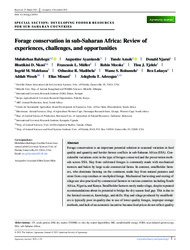Forage conservation in sub-Saharan Africa: Review ofexperiences, challenges, and opportunities
Date
2021-11-11Author
Gebremikael, Mulubrhan Balehegn
Ayantunde, Augustine
Amole, Tunde
Njarui, Donald
Bhutikini Douglas, Nkosi
Müller, Francuois
Meeske, Robin
Tjelele, Tlou J.
Malebana, Ingrid M.
Madibela, Othusitse Ricky
Boitumelo, Wame
Lukuyu, Ben
Addah, Weseh
Minani, Elias
Adesogan, Adegbola T.
Metadata
Show full item recordAbstract
Forage conservation is an important potential solution to seasonal variation in feed quality and quantity and herder-farmer conflicts in sub-Saharan Africa (SSA). Considerable variations exist in the type of forages conserved and the preservation methods across SSA. Hay from cultivated forages is commonly made with mechanical mowers and balers by large-scale commercial farms. In contrast, smallholder farmers, who dominate farming on the continent, make hay from natural pastures and straw from crop residues or stockpiled forage. Mechanized harvesting and storing of silage are also practiced by commercial farmers in various countries including South Africa, Nigeria, and Kenya. Smallholder farmers rarely make silage, despite repeated recommendations about its potential to bridge the dry season feed gap. This is due to the limited resources, knowledge, and skills. Hay and silage produced by smallholders is typically poor in quality due to use of lower quality forages, improper storage methods, and lack of an economic incentive because feed prices do not reflect quality in most regions. This paper discusses the status of forage conservation across SSA and recommends strategic interventions and technologies to improve the quantity, quality, safety, pricing, and utilization of preserved forages in SSA. Key deductions include the need to raise awareness about their role in bridging the feed gap, to build capacity and invest in appropriate technology, to optimize their production and use, to develop mechanisms to relate prices to quality, and to incentivize women and youth and the private sector to engage further in making and selling preserved forages.
URI
https://acsess.onlinelibrary.wiley.com/doi/epdf/10.1002/agj2.20954https://hdl.handle.net/13049/361
Collections
- Research articles [172]

